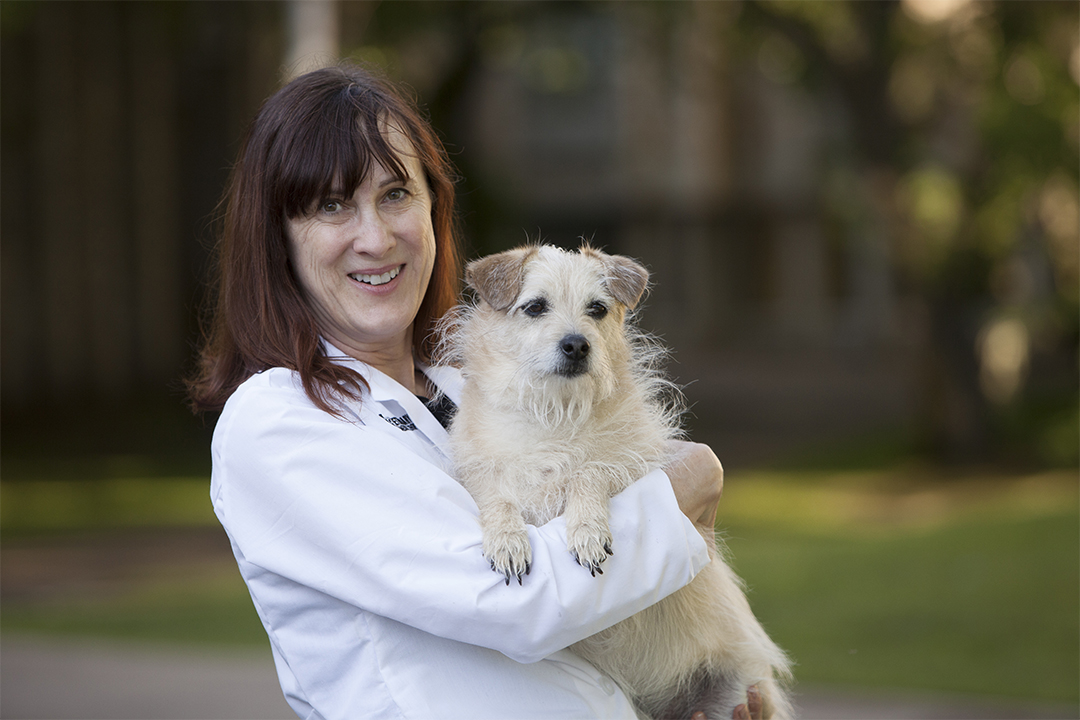
RapidArc advances cancer centre plan
The newly-acquired RapidArc radiation technology is a key part of the Western College of Veterinary Medicine’s plan to establish a centre for comparative oncology at the University of Saskatchewan, says WCVM Dean Dr. Douglas Freeman.
By Kathy FitzpatrickThe capacity to provide state-of-the-art cancer care is very important for veterinary referral centres such as the WCVM, Freeman notes.
“Pets are becoming more and more members of the family. And being able to provide cancer therapy for those pets to increase their comfortable life span is really important for people.”
While cancer care is a growing need, relatively few places have all of the clinical expertise and the treatment and diagnostic modalities to provide that care, he adds.
Along with RapidArc, another key piece of the plan is to expand the building where the college’s magnetic resonance imaging (MRI) unit and linear accelerator are located and then add a new PET-CT (positron emission tomography-computed tomography) scanner to the WCVM’s family of technologies.
PET-CT will aid the WCVM oncology team in identifying rapidly-growing cells, a very important element in cancer diagnostics and oncology research.
Freeman says the acquisition will make the WCVM one of very few veterinary facilities in North America — and the only one in Canada — to have MRI, CT and PET-CT units available at one site.
But that isn’t the only synergy he wants to capitalize on.
“Maybe more importantly for us here in Saskatchewan is the potential to integrate our work with the Saskatchewan Cancer Agency, the [university’s] College of Medicine and the other health sciences [colleges] – because the translational research capability in cancer is very important for human medicine as well as veterinary medicine.”
That, combined with the university’s other national research facilities such as the cyclotron and the synchrotron, are the making of a research powerhouse on campus.
One recent example of the calibre of translational research being done on campus is a collaborative study investigating the effectiveness of mini-beam radiation treatments (MBRT) on malignant brain tumours in dogs. The mini-beams are created using synchrotron-generated X-rays.
Dr. Vijayananda Kundapur, a radiation oncologist at the U of S College of Medicine, had already conducted a study on mice, using MBRT to deliver large doses of radiation that stopped the tumours’ growth without causing brain damage.
The next step was to test the procedure with dogs. With the help of Dr. Monique Mayer, professor of radiation oncology at the WCVM, 16 canine patients with spontaneous brain tumours were enrolled in a clinical trial.
“Having that technology where we can administer similar treatments is important to have if we want [the College of Medicine] to ask their research questions about humans, using our patients,” says Mayer.
It could be six months to a year before the study’s results are analyzed.
“Once those have come out, then [Dr. Kundapur] is going to take his research further towards making this an opportunity for people. It’s not available for humans right now,” she explains.
On the flip side, the project allows Mayer to investigate a new cancer treatment that could benefit dogs as well.
Freeman points out another advantage to canine-human translational research. Since dogs and people live in the same environment, both develop many of the same naturally-occurring spontaneous tumours. These tumours sometimes respond differently to treatment than the induced tumours that might be studied in laboratory animals.
Although RapidArc wasn’t used in the brain tumour study, Freeman notes that being able to deploy the most current treatment modalities allows the WCVM to conduct the most relevant translational research.
The addition of RapidArc offers a step up in teaching as well. Radiation oncology residents need to learn how to plan treatments with it “so they’re better prepared for offering good quality care wherever they go,” says Mayer.
It’s also critical for students in the college’s Doctor of Veterinary Medicine (DVM) program to be aware of the latest oncology therapies before they enter practice so they can inform their clients about all of the options available.
Always, it comes back to the patient.
“I think the biggest thing … as we move forward with the cancer centre, [is] to be able to offer the [most] technologically advanced level of care,” Mayer says.
While the WCVM already offers a full array of oncology treatments, the new cancer centre is intended to go beyond the scope of a single college — possibly with more significant resources.
The Allard Foundation Chair in Veterinary Oncology — a new WCVM position for which $650,000 has already been raised — will work closely with the centre’s faculty and staff to advance its teaching and research mandate. Once the chair’s position is filled, that person will focus on accelerating veterinary oncology research and building relationships with the oncology research community on campus and throughout the world.
Meanwhile, other work is underway to meet the WCVM’s growing research aspirations. Dr. Valerie MacDonald-Dickinson, associate professor in veterinary medical oncology, is pursuing membership for the college in a National Institutes of Health clinical trial consortium. Once approved, patients from the WCVM would be able to participate in those clinical trials that take place across North America.
